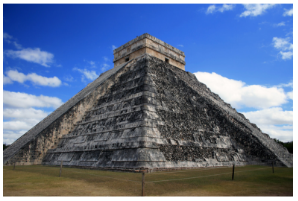The Mayan ruins of Chichen Itza were part of the Maya civilization. Chichen Itza, pronounced chee-chehn eet-sah is the capital of Yucatan State, Mexico. This is the ancient sacred Mayan city of Itza whose name translates as ‘mouth of the Well of Itza’. In the Mayan language Chi means mouth, Chen means well and Itza is just the name given to the tribe who inhabit the area. The main attraction at the Mayan ruins site is the Kukulkans Pyramid.
Kukulkans Pyramid
Probably the most recognised attraction of the Mayan ruins of Chichen Itza is this magnificent pyramid is called ‘El Castillo del Serpiente Emplumado’ meaning ‘Castle of the Plumed Serpent’. When the pyramid was in its original state it had 4 stairways, one on each side, each with 91 steps. This makes a total of 364 steps, add this to the one common step and you get a total of 365 steps, possibly one for each day of the year. There is a general misconception that the one common step is the one all around the top, but it is my understanding that the common step is the ground and the people of Maya had an advanced number system that started at zero. Either way, there are 365 which could be a direct representation of the number of days in the year.
Further to enhance the theory that this building has a strong link to the calendar there is a phenomenon that happens twice a year on the spring and autumn equinox. The light shines in such a way that it lights up seven triangular shapes down one side of the El Castillo pyramid. This is said to represent the body of a serpent which cascades down the pyramid until it joins the carved serpents head at the foot of the stairway. If this was intended during construction, and there is no evidence to suggest otherwise, you have got to admit this is amazing.
Quetzal bird chirping back at you
Another interesting fact about the pyramid is its acoustic properties and how it affects sound made in front of the steps. If you visit chichén itzá often jokingly referred to by visitors as Chicken pizza your guide will no doubt show you this but if he doesn’t or you don’t go with a guide make sure you try this out. Stand anywhere in front of the steps (can be quite a way away) and clap, instead of hearing a clapping noise you will hear a kind of twanging noise. This is said to be the echo of the Quetzal bird chirping back at you from the top of the main pyramid. There are a number of videos on youTube if you want to hear this noise for yourself, here is an example if it is still active Chichen its bird sound on youtube
The Temple of the Warriors at Chichen Itza
The Temple of the Warriors at chichen itza is a magnificent structure consisting of a large temple surrounded by hundreds of columns featuring carved warriors. It is thought that the columns supported a wooden roof structure, which has long since deteriorated.
The Observatory Chichen Itza
The Observatory the tower was used for astronomy with its windows being aligned with the four cardinal directions and the position of the setting sun at the equinoxes. A very impressive structure!
Platform of skulls
The platform of skulls is a large platform has many skulls carved into It which may at first suggest it was some kind of burial site. But the Mayan people did not really bury there dead in the same way we do and this platform was used to kind of celebrate military conquests. Prisoners heads would be displayed here, or even brought back and actually beheaded on it. This served as a constant reminder of there military aggression and a terrifying warning to anyone who wished to attack them
Cenote Chichen Itza are the Entrance to the underworld
Although the central pyramid is probably the main attraction and image displayed on most promotional material related to Chichen Itza it is not the reason the city exists and probably not the most important area to the Maya civilisation all those years ago, That is the cenote Chichen Itza!
Cenotes are kind of deep underground sinkholes, sometimes acting as mouths to underground rivers. The Mayan people held these places in high ritual status, believing them to be the entrance to the underworld. They would make human sacrifices to the rain god, as there whole way of life revolved around getting enough rain to grow there own food.


